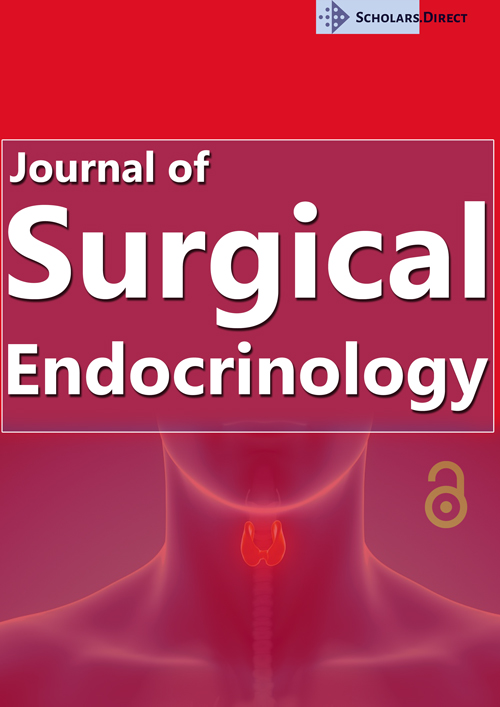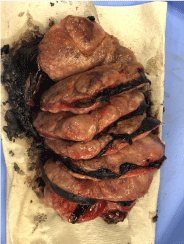Robot-Assisted Laparoscopic Adrenalectomy for Large Adrenocortical Carcinoma in a 17-year old Patient
Abstract
Surgical resection remains the standard of care for adrenocortical carcinoma (ACC). The optimal approach for complete surgical resection is constantly evolving as surgeons seek to attain more minimally invasive methods that align with appropriate patient care. While an open approach is most frequently employed, as surgeons seek more minimally invasive methods, laparoscopy is being used more and more in practice. Although robotic-assisted laparoscopy as a means to resect ACC has only been mentioned a handful of times in the literature, it has been when pertaining to tumors under 10 cm and in adults. We seek to describe the first reported robot-assisted-laparoscopic adrenalectomy used to resect an 11cm ACC in a pediatric patient.
Introduction
Complete surgical resection is the only option for potentially curative treatment of adrenocortical carcinoma. Historically, open adrenalectomy has been used for larger tumors and those that demonstrate invasion, while laparoscopy is now being used more and more for smaller, more localized tumors. In comparative studies examining the differences in outcomes for ACC in laparoscopy versus open surgery, many have demonstrated no difference in recurrence-free survival, presence of metastases, and overall survival [1-4]. One study that compared 46 patients who underwent laparoscopy versus 100 that underwent open surgery found higher positive margin rates (30 v. 18%, respectively) and shorter time to recurrence with laparoscopy [4]. While there is a paucity of data with respect to robotic-assisted laparoscopy in ACC patients, it's first use was documented by Zafar and Abaza in a study published in 2007 on the resection of an 8cm ACC in an adult patient [5]. Much more research needs to be done to assess the efficacy of robot-assisted adrenalectomy as it relates to intra-operative and post-operative outcomes, especially in the pediatric population. However, as it stands, it remains a promising area of interest and potential solution to a rare yet devastating disease.
Case Presentation
A 17-year old male presented to the ER with sudden-onset flank pain of 12 hours' duration. During questioning, the patient admitted to a 2-year history of new-onset high blood pressure, fatigue, muscle weakness in his extremities, hair loss, and weight gain. His past medical history was significant for asthma and he was on no prescribed medication at the time.Other than a blood pressure of 175/113, his vital signs were within normal limits. On examination, he had findings of moon-like facies, plethora, acne, prominent abdominal striae, and supraclavicular fat maldistribution. In addition to a urinalysis consistent with a ureteral stone, his blood demonstrated low eosinophils, neutrophilia, lymphopenia, hypokalemia, and hypernatremia.
On imaging, the CT scan showed both a 9.1 x 10.8 x 9.1 cm heterogeneously-enhancing right suprarenal mass and a 3mm ureteral stone in the right ureter. After being discharged the same day with plans for medical management of the ureteral stone, the patient followed up the following week with the endocrinologist for the right adrenal mass. His blood work demonstrated high levels of cortisol consistent with the diagnosis of ACC causing Cushing's syndrome. After a PET scan showed no signs of distant metastases, the patient was placed on appropriate doses of Eplenerone, Labetalol, and Potassium Chloride to manage his symptoms prior to surgery. He underwent a robot-assisted laparoscopic right radical adrenalectomy with lymphadenectomy utilizing a trans abdominal approach.
Histological sections demonstrated adrenocortical neoplasm with capsular invasion (positive margins) and the presence of the SF1 marker in the tumor cells. Pathological stage classification was pT3N1MOR1 consistent with Stage III low grade ACC. The patient was started on dexamethasone immediately post-op to and soon thereafter was placed on adjuvant mitotane with a trials of radiation therapy. He remains disease-free 1-year after surgical resection with resolution of all cortisol-related symptoms.
Discussion
ACC is a rare neoplasm with only 1-2 cases per million diagnosed each year [6]. The female to male ratio of the disease is 1.5 - 2.5 to 1[7]. In children, ACC is also very rare with an incidence of 1-1.5 per million per year [8]. It has a bimodal age distribution both during1-10-years old and the fifth decade of life [9]. While it is thought to be more aggressive in adults, both adults and children are over 50% likely to have a functional tumor -more likely symptoms of cortisol excess in adults and virilization in children. In fact, many children present with what appears to be early puberty as the presenting symptom. In a study done in Brazil on pediatric ACC, of 20 children that eventually received surgical resection of the tumor, 83% had a functional tumor of which virilization was most common [10].
Most cases of ACC appear to be sporadic, while a small portion are associated with hereditary cancer syndromes such as Li-Fraumeni, Beckwith-Wiedemann, or MEN1. In the sporadic form, of which this patient was diagnosed, TP53 is the most frequently mutated gene located on chromosome 17p13 (rearrangement of intron 7 was seen this patient) [11]. Protein markers/genes play a role in determining the prognosis of the tumor in addition to using the Weiss criteria. It utilizes five criteria to assess the likelihood of malignancy: > 6 mitoses/50 hpf, ≤ 25% clear tumor cells in cytoplasm, abnormal mitosis, necrosis, and capsular invasion [11]. Other tumor markers, as aforementioned, include Ki-67 proliferation index and tumor markers such as TP53, IGF-2, and cyclin E [11]. The neoplasm is staged based on TNM staging system from the AJCC/UICC, in which Stage IV disease exclusively refers to disease with distant metastases.
The 5-year, disease-specific survival rates range from 82% at stage I disease down to 13% at stage IV with an overall rate of 51% [12]. Due to such an aggressive form of cancer, surgical resection is the only curative form of management and is always performed unless the patient is a poor surgical candidate. Because of the rarity of ACC, the standard surgical procedure is constantly being re-evaluated and altered. Historically, open adrenalectomy has been the recommended treatment, but the use of laparoscopy and robot-assisted laparoscopy is being explored more often over time. The advantages of using robotics are three-dimensional optics, a magnified view of the body with great resolution and depth, seven degrees of freedom at the wrists for operating instruments which serve to filter out tremors and allows precise movement, and comfortable seating [8]. On the other hand, some disadvantages quoted in the literature are longer operation time and increased costs of the operation [8].
Whether cost remains a barrier to its implementation as a standard procedure remains to be seen. However small the amount of literature is on robot-assisted laparoscopies for ACC, there is a great deal of literature assessing it's use in surgical resection of other benign adrenal pathologies. In a meta-analysis done on 27 research studies looking at 1162 adrenalectomies (747 robot-assisted, 415 laparoscopic), no difference was found between the two methods as it relates to intra-operative/post-operative complications, overall mortality, conversion to open adrenalectomy, and blood loss during the surgery [13]. In fact, the study showed that the patients whose surgeries were robot-assisted had shorter hospitals than laparoscopy alone [13].
As it refers to our patient, we decided to do robot-assisted because the surgeons were highly trained in robotic surgery, it was very feasible, and it was determined to be a safe and proper technique for achieving complete resection without any added tumor spillage. The patient had no postoperative complications as it related to the surgery and the hospital stay was not affected by the surgical procedure. Almost 1-year after the surgery, the patient remains cancer-free. Due to the high risk of recurrence, mitotane therapy was initiated for the patient and he will continue on the medication for a total of 5-years. Additionally, the patient received three trials of radiation therapy in order to further decrease the recurrence risk and eliminate any micrometastases that were not visible on imaging. In accordance with the current recommendations, the patient will continue disease monitoring in the form of laboratory testing and CT scans every three months for the first two years. Further surveillance of disease progression will be continued or altered based upon the disease status at the 2-year mark.
References
- Porpiglia F, Fiori C, Daffara F, et al. (2010) Retrospective evaluation of the outcome of open versus laparoscopic adrenalectomy for stage I and II adrenocortical cancer. Eur Urol 57: 873-888.
- Brix D, Allolio B, Fenske W, et al. (2010) Laparoscopic versus open adrenalectomy for adrenocortical carcinoma: Surgical and oncologic outcome in 152 patients. Eur Urol 58: 609-615.
- Lombardi CP, Raffaelli M, De Crea C, et al. (2012) Open versus endoscopic adrenalectomy in the treatment of localized (stage I/II) adrenocortical carcinoma: Results of a multiinstitutional Italian survey. Surgery 152: 1158-1164.
- Miller BS, Gauger PG, Hammer GD, et al. (2012) Resection of adrenocortical carcinoma is less complete and local recurrence occurs sooner and more often after laparoscopic adrenalectomy than after open adrenalectomy. Surgery 152: 1150-1157.
- Zafar SS, Abaza R (2008) Robot-assisted laparoscopic adrenalectomy for adrenocortical carcinoma: Initial report and review of the literature. J Endourol 22: 985-989.
- Kerkhofs TM, Verhoeven RH, Van der Zwan JM, et al. (2013) Adrenocortical carcinoma: A population-based study on incidence and survival in the Netherlands since 1993. Eur J Cancer 49: 2579-2586.
- Pahwa M, Pahwa AR, Batra R, et al. (2015) Robotic assisted laparoscopic adrenalectomy: Initial experience from a tertiary care centre in India. J Minim Access Surg 11: 83-86.
- Miller BS, Doherty GM (2014) Surgical management of adrenocortical tumours. Nat Rev Endocrinol 10: 282-292.
- Xiao XR, Ye LY, Shi LX, et al. (1998) Diagnosis and treatment of adrenal tumours: A review of 35 years' experience. Br J Urol 82: 199-205.
- Ng L, Libertino JM (2003) Adrenocortical carcinoma: Diagnosis, evaluation and treatment. J Urol 169: 5-11.
- Sandrini R, Ribeiro RC, DeLacerda L (1997) Childhood adrenocortical tumors. J Clin Endocrinol Metab 82: 2027.
- Aubert S, Wacrenier A, Leroy X, et al. (2002) Weiss system revisited: A clinicopathologic and immunohistochemical study of 49 adrenocortical tumors. Am J Surg Pathol 26: 1612.
- Fassnacht M, Johanssen S, Quinkler M, et al. (2009) Limited prognostic value of the 2004 International Union against cancer staging classification for adrenocortical carcinoma: Proposal for a Revised TNM Classification. Cancer 115: 243-250.
Corresponding Author
Michael Boncaldo, St. Vincent's Medical Center, Bridgeport, CT, USA.
Copyright
© 2022 Boncaldo M. This is an open-access article distributed under the terms of the Creative Commons Attribution License, which permits unrestricted use, distribution, and reproduction in any medium, provided the original author and source are credited.





